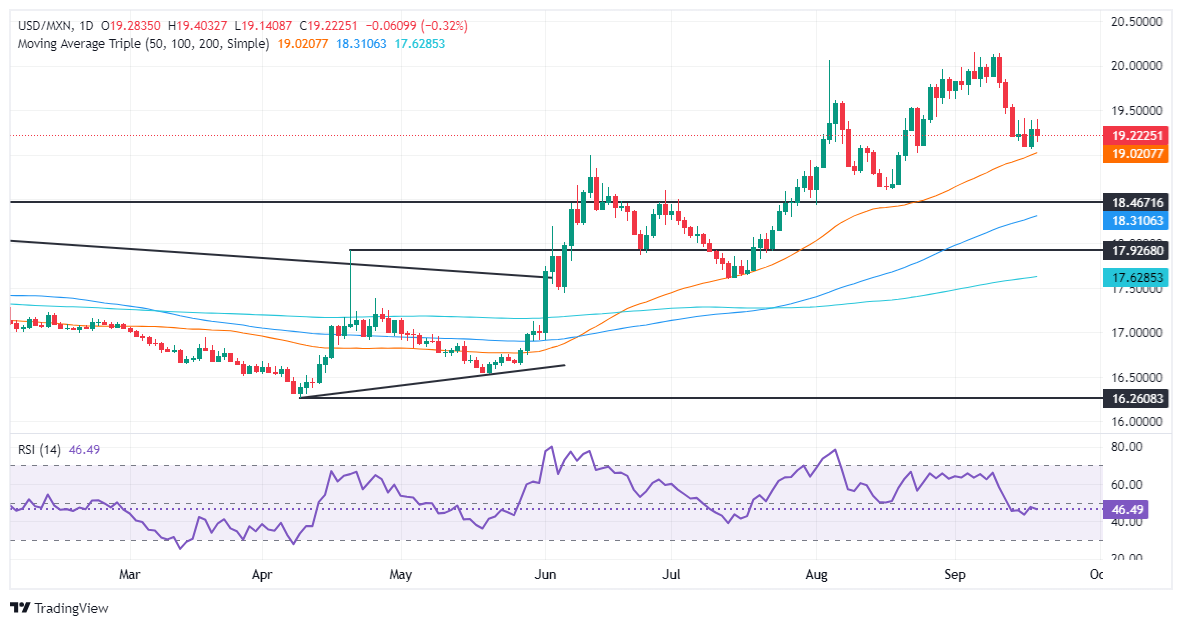- Mexican Peso softens after Fed's 50 bps rate cut.
- Fed projects federal funds rate at 4.4% for 2024, balancing price stability and employment goals.
- Investors await Banxico's upcoming decision with a 0.25% rate cut expected on September 26.
The Mexican Peso softens slightly against the US Dollar during the North American session on Thursday after the Federal Reserve (Fed) lowered interest rates for the first time in four years. Data from the United States (US) failed to spark a movement on the exotic pair as the USD/MXN trades at 19.31, post modest gains of over 0.17%.
A scarce Mexican economic docket leaves the emerging market currency leaning into the dynamics of the US economy. On Wednesday, the Fed cut rates by 50 basis points (bps) as it grew confident that inflation will “sustainably” attain its 2% goal and the labor market won’t soften further. In its monetary policy statement, Fed Chair Jerome Powell acknowledged that the dual mandate of price stability and maximum employment is now roughly balanced while noting that the economic outlook remains uncertain.
In the same meeting, Fed officials updated the Summary of Economic Projections (SEP) or Dot Plot, in which they foresee the federal funds rate finishing 2024 at 4.4%.
Recently, the US Department of Labor revealed that the number of Americans filing for unemployment benefits for the week ending September 14 was lower than expected but improved compared to the last reading.
The USD/MXN exotic pair rose toward a daily high of 19.40 after the data as this could dent the US central bank from easing policy aggressively, instead sticking to quarter percentage point reductions.
Meanwhile, investor eyes are on the Bank of Mexico (Banxico), which is expected to lower rates by 0.25% at the September 26 monetary policy meeting decision.
Daily digest market movers: Mexican Peso firm after Fed decision
- The widening of the interest rate differential between Mexico and the US could warrant further downside in the USD/MXN. Nevertheless, fears of the judicial reform capped the Mexican Peso from rallying.
- According to different banks and rating agencies, the impact of overhauling the judicial system remains far from being felt. The lack of a state of law and transparency could be factors in adjusting Mexico’s creditworthiness over the longer term.
- US Initial Jobless Claims for the week ending September 14 dipped from 231K to 219K, below estimates of 230K.
- US Existing Home Sales plunged 2.5% MoM in August, after dipping from 3.96 million to 3.86 million, declining for the fourth time in the year.
- During his press conference, Fed Chair Powell said the risks of inflation diminished and underscored that the economy remained strong. He kept the Fed’s options open, meaning that if inflation persists they can adjust the pace of easing.
- Powell added that SEP data shows the Committee is not in a rush to normalize policy.
- Fed expects inflation to condense to 2.6% in 2024, 2.2% in 2025 and 2% by 2026, according to the Core Personal Consumption Expenditures Price Index.
- Fed officials estimate the US economy will grow at a 2% pace in 2024, with the Unemployment Rate rising to 4.4% by the end of the year.
- December 2024 fed funds rate futures contracting suggests that the Fed might lower rates by at least 69 basis points, implying that in the following two meetings, the market expects one 50 bps and one 25 bps rate cut left in 2024.
USD/MXN technical outlook: Mexican Peso falls as USD/MXN holds gains above 19.30
The USD/MXN uptrend remains in place, though the pair has failed to rally following the Fed’s decision. Next week, Banxico’s policy meeting could push the exchange rate out of the 19.00 – 19.50 range.
Momentum remains mixed but in the short-term it favors sellers as depicted by the Relative Strength Index (RSI).
That said, if the USD/MXN drops below the September 18 low of 19.06, it will expose the psychological 19.00 figure. Further losses lie underneath with the next support being the 50-day Simple Moving Average (SMA) at 18.99, followed by the last cycle low of 18.59, the August 19 daily low.
Conversely, If the USD/MXN climbs above 19.50, the next resistance would be the 20.00 psychological level. Further upside emerges at the yearly peak at 20.22, followed by the 20.50 mark.
Mexican Peso FAQs
The Mexican Peso (MXN) is the most traded currency among its Latin American peers. Its value is broadly determined by the performance of the Mexican economy, the country’s central bank’s policy, the amount of foreign investment in the country and even the levels of remittances sent by Mexicans who live abroad, particularly in the United States. Geopolitical trends can also move MXN: for example, the process of nearshoring – or the decision by some firms to relocate manufacturing capacity and supply chains closer to their home countries – is also seen as a catalyst for the Mexican currency as the country is considered a key manufacturing hub in the American continent. Another catalyst for MXN is Oil prices as Mexico is a key exporter of the commodity.
The main objective of Mexico’s central bank, also known as Banxico, is to maintain inflation at low and stable levels (at or close to its target of 3%, the midpoint in a tolerance band of between 2% and 4%). To this end, the bank sets an appropriate level of interest rates. When inflation is too high, Banxico will attempt to tame it by raising interest rates, making it more expensive for households and businesses to borrow money, thus cooling demand and the overall economy. Higher interest rates are generally positive for the Mexican Peso (MXN) as they lead to higher yields, making the country a more attractive place for investors. On the contrary, lower interest rates tend to weaken MXN.
Macroeconomic data releases are key to assess the state of the economy and can have an impact on the Mexican Peso (MXN) valuation. A strong Mexican economy, based on high economic growth, low unemployment and high confidence is good for MXN. Not only does it attract more foreign investment but it may encourage the Bank of Mexico (Banxico) to increase interest rates, particularly if this strength comes together with elevated inflation. However, if economic data is weak, MXN is likely to depreciate.
As an emerging-market currency, the Mexican Peso (MXN) tends to strive during risk-on periods, or when investors perceive that broader market risks are low and thus are eager to engage with investments that carry a higher risk. Conversely, MXN tends to weaken at times of market turbulence or economic uncertainty as investors tend to sell higher-risk assets and flee to the more-stable safe havens.
Information on these pages contains forward-looking statements that involve risks and uncertainties. Markets and instruments profiled on this page are for informational purposes only and should not in any way come across as a recommendation to buy or sell in these assets. You should do your own thorough research before making any investment decisions. FXStreet does not in any way guarantee that this information is free from mistakes, errors, or material misstatements. It also does not guarantee that this information is of a timely nature. Investing in Open Markets involves a great deal of risk, including the loss of all or a portion of your investment, as well as emotional distress. All risks, losses and costs associated with investing, including total loss of principal, are your responsibility. The views and opinions expressed in this article are those of the authors and do not necessarily reflect the official policy or position of FXStreet nor its advertisers. The author will not be held responsible for information that is found at the end of links posted on this page.
If not otherwise explicitly mentioned in the body of the article, at the time of writing, the author has no position in any stock mentioned in this article and no business relationship with any company mentioned. The author has not received compensation for writing this article, other than from FXStreet.
FXStreet and the author do not provide personalized recommendations. The author makes no representations as to the accuracy, completeness, or suitability of this information. FXStreet and the author will not be liable for any errors, omissions or any losses, injuries or damages arising from this information and its display or use. Errors and omissions excepted.
The author and FXStreet are not registered investment advisors and nothing in this article is intended to be investment advice.
Recommended content
Editors’ Picks

EUR/USD keeps the bullish bias intact around 1.0500
A mild rebound in the Greenback prompts EUR/USD to recede from earlier peaks and settle around the 1.0500 neighbourhood on Tuesday, while market participants keep monitoring developments around US tariffs.

GBP/USD comes under pressure, revisits 1.2650
GBP/USD failed to extend its rebound further north of the 1.2680 zone on Tuesday, sparking instead a corrective move to the mid-1.2600s amid a mildt bounce in the Greenback.

Gold deflates below $2,900, six-day lows
The corrective move in Gold prices remains well and sound and now prompts the yellow metal to breach the key $2,900 mark per ounce troy despite the intense downside bias in the US Dollar and the generalised decline in US yields.

Bitcoin edges below $90,000, ending its long streak of consolidation
Bitcoin (BTC) continues to trade in red, reaching a low of $88,200 during Tuesday’s early Europen trading session and hitting the lowest level since mid-November after falling 4.89% the previous day.

Five fundamentals for the week: Fallout from German vote, Fed's favorite figure stand out Premium
Statements, not facts, are set to dominate the last week of February. Further fallout from Germany's elections and new comments from Trump on trade may overshadow most figures –but not the Fed's favorite inflation figure.

The Best brokers to trade EUR/USD
SPONSORED Discover the top brokers for trading EUR/USD in 2025. Our list features brokers with competitive spreads, fast execution, and powerful platforms. Whether you're a beginner or an expert, find the right partner to navigate the dynamic Forex market.
